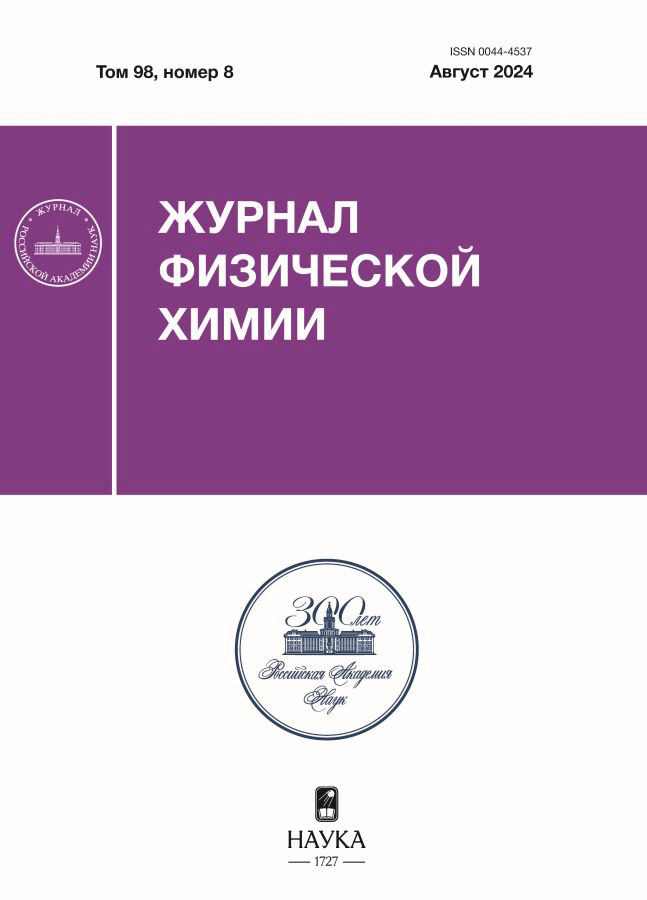Моделирование геометрии полиенов в основном электронном состоянии
- Autores: Поддубный В.В.1, Глебов И.О.1
-
Afiliações:
- Московский государственного университета имени М. В. Ломоносова
- Edição: Volume 98, Nº 8 (2024)
- Páginas: 88-94
- Seção: STRUCTURE OF MATTER AND QUANTUM CHEMISTRY
- ##submission.dateSubmitted##: 27.02.2025
- ##submission.datePublished##: 22.08.2024
- URL: https://rjonco.com/0044-4537/article/view/668932
- DOI: https://doi.org/10.31857/S0044453724080124
- EDN: https://elibrary.ru/PJHMAW
- ID: 668932
Citar
Texto integral
Resumo
Рассмотрена точность описания геометрии полиенов в их основном электронном состоянии различными методами. Для достижения высокой точности предложено использовать метод SCS-MP2 с учетом корреляции всех электронов, включая остовные, и с использованием атомного базиса cc-pwCVTZ. Показано, что при использовании этого подхода ошибки в длинах C–C-связей не превышают 0.003 Å. Использование приближений RIJCOSX и DLPNO ускоряет расчеты без значимого увеличения ошибок длин связей, но позволяет использовать предложенный подход для описания таких крупных систем как каротиноиды.
Palavras-chave
Texto integral
Sobre autores
В. Поддубный
Московский государственного университета имени М. В. Ломоносова
Autor responsável pela correspondência
Email: vvpoddubnyy@gmail.com
Химический факультет
Rússia, 119991, МоскваИ. Глебов
Московский государственного университета имени М. В. Ломоносова
Email: vvpoddubnyy@gmail.com
Химический факультет
Rússia, 119991, МоскваBibliografia
- Frank H.A., Cogdell R.J. // Photochem Photobiol. 1996. V. 63. P. 257. https://doi.org/10.1111/j.1751-1097.1996.tb03022.x
- Ruban A.V. // Plant Physiol. 2016. V. 170. P. 1903. https://doi.org/10.1104/pp.15.01935
- Wehling A., Walla P.J. // Photosynth Res. 2006. V. 90. P. 101. https://doi.org/10.1007/s11120-006-9088-2
- Kozlov M.I, Poddubnyy V.V. // J. Phys. Chem. B. 2020. V.124. P. 5780. https://doi.org/10.1021/acs.jpcb.0c02511
- Khokhlov D., Belov A. // J. Phys. Chem. A. 2022. V.126. P. 4376. https://doi.org/10.1021/acs.jpca.2c02485
- Harmony M.D. // J. Chem. Phys. 1990. V. 93. P. 7522. https://doi.org/10.1063/1.459380
- Puzzarini C., Taylor P.R. // J. Chem. Phys. 2005. V. 122. P. 54315. http://dx.doi.org/10.1063/1.1830437
- Craig N.C., Demaison J., Groner P., et al. // J. Phys. Chem. A. 2015. V. 119. P. 195. http://dx.doi.org/10.1021/jp510237h
- Feller D., Craig N.C. // Ibid. 2009. V. 113. P. 1601. http://dx.doi.org/10.1021/jp8095709
- Barborini M., Guidoni L. // J. Chem. Theory Comput. 2015. V. 11. P. 508. https://doi.org/10.1021/ct501157f
- Kupka T., Buczek A., Broda M.A, et al. // J. Mol. Model. 2016. V. 22. P. 101. http://dx.doi.org/10.1007/s00894-016-2969-1
- Djebaili A., Labidi N.S. // J. Saudi Chem. Soc. 2012. V. 16. P. 437. http://dx.doi.org/10.1016/j.jscs.2011.09.009
- Salzner U., Aydin A. // J. Chem. Theory Comput. 2011. V. 7. P. 2568. http://dx.doi.org/10.1021/ct2003447
- Donohoo-Vallett P.J., Bragg A.E. // J. Phys. Chem. B. 2015. V. 119. P. 3583. http://dx.doi.org/10.1021/jp512693e
- Baughman R.H., Kohler B.E., Levy I.J., Spangler C. // Synth Met. 1985. V. 11. P. 37. http://dx.doi.org/10.1016/0379-6779(85)90172-9
- Wykes M., Su N.Q., Xu X., et al. // J. Chem. Theory Comput. 2015. V. 11. P. 832. http://dx.doi.org/10.1021/ct500986b
- Jacquemin D., Adamo C. // Ibid. 2011. V. 7. P. 369. http://dx.doi.org/10.1021/ct1006532
- Neese F. // Wiley Interdiscip. Rev. Comput. Mol. Sci. 2012. V. 2. P. 73. http://dx.doi.org/10.1002/wcms.81
- Neese F. // Ibid. 2022. V. 12. http://dx.doi.org/10.1002/wcms.1606
- Berry R.J., Harmony M.D. // Struct. Chem. 1990. V.1. P. 49. http://dx.doi.org/10.1007/BF00675784
- Vogt N., Vogt J. Structure Data of Free Polyatomic Molecules. 1st ed. Cham, Switzerland: Springer Nature; 2020. http://dx.doi.org/10.1007/978-3-030-29430-4
- Neese F., Schwabe T., Kossmann S., et al. // J. Chem. Theory Comput. 2009. V. 5. P. 3060. http://dx.doi.org/10.1021/ct9003299
- Fink R.F. // J. Chem. Phys. 2016. V. 145. P. 184101. http://dx.doi.org/10.1063/1.4966689
- Fink R.F. // Ibid. 2010. V. 133. P. 174113. http://dx.doi.org/10.1063/1.3503041
- Neese F., Wennmohs F., Hansen A., Becker U. // Chem Phys. 2009. V. 356. P. 98. http://dx.doi.org/10.1016/j.chemphys.2008.10.036
- Pinski P., Riplinger C., Valeev E.F., Neese F. // J. Chem. Phys. 2015. V. 143. P. 034108. http://dx.doi.org/10.1063/1.4926879
Arquivos suplementares


















